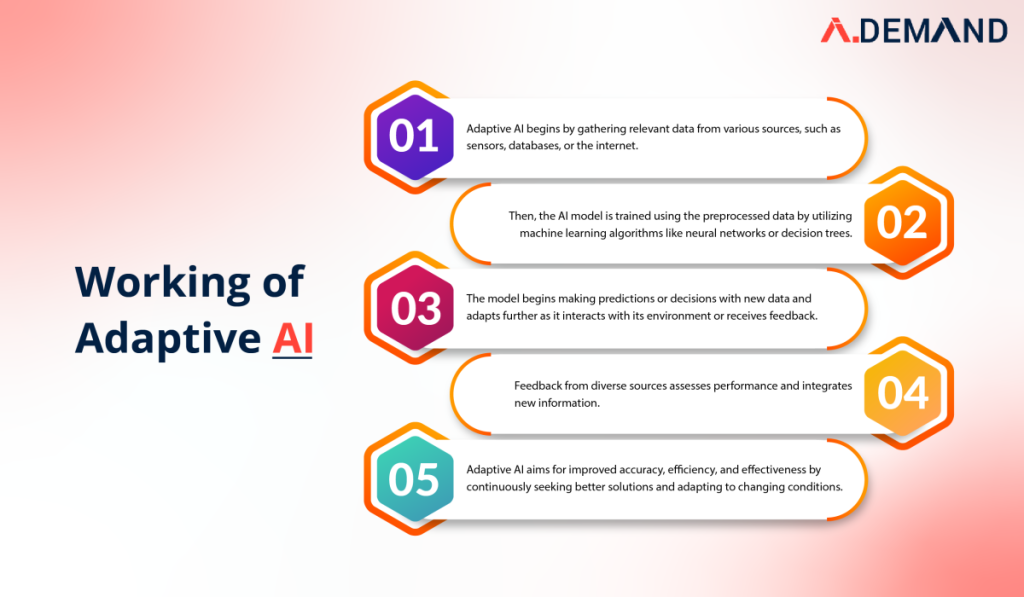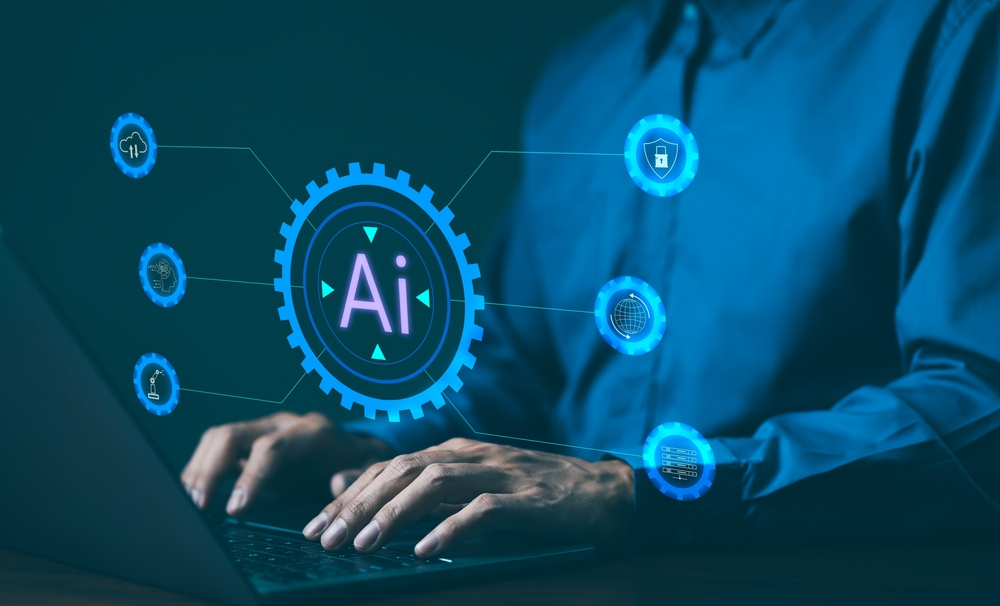Highlights:
- Adaptive AI relies on self-learning mechanisms such as reinforcement learning or transfer learning to improve autonomously over time.
- Adaptive AI enhances market analysis and investment decisions by identifying patterns and trends that might elude human analysts, leading to more accurate market predictions.
Within the extensive landscape of AI technologies and methodologies, adaptive AI emerges as a prominent pioneer, garnering substantial momentum. This evolving methodology signifies a paradigm shift in machine interaction and learning within dynamic environments, with the potential to fundamentally transform the functionality of connected ecosystem toward heightened intelligence, responsiveness, and adaptability.
What is Adaptive AI?
It endeavors to craft intelligent systems that can adjust to dynamic conditions and assimilate knowledge from novel encounters. Such AI models are engineered to exhibit flexibility and are adept at altering their actions based on fresh data or shifts in their surroundings.
This technology harnesses an array of methodologies and algorithms to empower machines in learning with practice, identifying patterns, and forecasting outcomes. Among these techniques are machine learning, neural networks, reinforcement learning, and evolutionary algorithms.
Adaptive AI development, at its core, embodies a dynamic fusion of sophisticated components and machine learning principles designed to autonomously respond and evolve according to the changing environments, data inputs, and user interactions.
Components of Adaptive AI
It represents an intelligent technology that improves with experience through learning and adaptation. Now, let’s delve into its fundamental elements:
-
Machine learning algorithms
Machine learning serves as the foundation for AI’s capacity to glean insights from data and subsequently utilize that knowledge to make predictions or decisions. This element constitutes three major categories: supervised, unsupervised, and deep reinforcement learning.
-
Deep learning and neural networks
Neural networks mimic the structure of the human brain, comprising interconnected layers of nodes or neurons that collaborate. Deep learning employs highly intricate neural networks with numerous layers to discern intricate patterns within data. This capability enables AI to accomplish tasks such as image recognition, speech comprehension, and natural language processing.
-
Meta learning and transfer learning
Transfer learning enables AI to leverage insights gained from one task to aid in a different yet connected task, expediting the learning process by avoiding starting from square one.
Meta-learning refines adaptive learning of AI mechanisms, enhancing its ability to assimilate new tasks or adapt to changes more efficiently and swiftly.
-
Evolutionary algorithms
The natural process of evolution inspires evolutionary AI algorithms. AI utilizes these patterns to enhance its performance gradually over time, choosing optimal solutions and making incremental adjustments for improvement.
Understanding the intricate functioning of adaptive AI systems requires delving into the dynamic interplay between sophisticated algorithms, vast datasets, and iterative learning mechanisms.
How Adaptive AI Works?
Working involves continual learning from data, enabling dynamic adjustments and iterative improvements over time, ultimately enhancing its effectiveness in various tasks.

Strategically Implementing Adaptive AI
Implementation entails a meticulous series of strategic steps, each crucial for harnessing its transformative potential.
-
Stating objective
First, establish the system’s objectives by defining desired outcomes, determining key performance indicators, and identifying the target audience.
-
Collecting data
Data forms the foundation for training machine learning models to make informed decisions. When gathering data for AI, factors to consider include relevance, timeliness, diversity, storage, and privacy.
-
Training model
Training models entails instructing ML models with datasets to enable prediction-making and underpin decision-making processes. When training such AI models, exercise caution in algorithm selection, data preparation, model evaluation, and refinement, leading to secure adaptive AI implementation.
-
Contextual analyzing
Contextual analysis aids real-time responses and informed decision-making. It involves assessing new sources of data, processing methods, model predictions, and establishing a feedback loop.
-
Assessing the AI model
Various techniques are employed to assess an artificial intelligence model, encompassing feature engineering, transfer learning, hyperparameter tuning, and other methodologies.
-
Deploying the model
The deployment of adaptive AI system encompasses tasks such as model preparation, infrastructure setup, model management, integration, and, ultimately, deployment.
-
Monitoring and improving
Monitoring guarantees the smooth functioning of the AI system, typically involving steps such as performance monitoring, model retraining, data collection, analysis, system updates, and user feedback.
Understanding the fundamental disparities between adaptive and traditional AI methodologies is crucial in navigating the evolving landscape of artificial intelligence.
Crucial Difference between Traditional AI and Adaptive AI
The distinction between AI technologies delineates a fundamental contrast in approach and capability.
| Traditional AI | Adaptive AI |
|---|---|
| Traditional AI typically relies on static models and algorithms designed to perform specific tasks without adapting to new data or circumstances. | Adaptive AI tools, on the other hand, employs dynamic learning mechanisms that enable continuous adjustment and improvement based on evolving data and changing conditions. |
| Traditional AI systems may struggle to handle novel or unexpected situations for which they were not explicitly programmed. | It is better equipped to respond to novel situations by learning from new data and experiences, allowing it to adapt its behavior accordingly. |
| Traditional AI often requires extensive manual tuning and tweaking of models and algorithms to achieve optimal performance. | It relies on self-learning mechanisms such as reinforcement learning or transfer learning to improve autonomously over time. |
| Traditional AI systems are typically designed for specific tasks or domains and may lack the flexibility to adapt to different scenarios. | It exhibits greater versatility, as it can apply learned knowledge and skills across various tasks or domains, due to its ability to generalize from past experiences and adapt to new challenges. |
Applications have become increasingly prominent and transformative, revolutionizing industries and technological interaction.
Applications of Adaptive AI
Multifaceted adaptive AI use cases drive unprecedented levels of efficiency, intelligence, and adaptability across diverse industries.
-
Healthcare
AI adaptability is alleviating healthcare industry challenges by offering personalized care through real-time analysis of patient data, including vital signs, lab results, and medical histories, to predict potential diseases or conditions.
-
Finance
Adaptable AI enhances market analysis and investment decisions by identifying patterns and trends that might elude human analysts, leading to more accurate market predictions. It also combats financial fraud, like credit card scams, by learning from past transactions to spot unusual activity in real-time.
-
Manufacturing
Adaptive AI technology can examine production data, including machine performance and energy usage, to pinpoint opportunities for enhancing efficiency.
-
Transportation
Some of the best adaptive AI systems are deployed in the transportation sector to enhance traffic flow and alleviate congestion. For instance, AI algorithms can assess traffic patterns and dynamically adjust traffic signals, resulting in shorter commute durations and reduced road congestion.
Conclusion
The future of adaptive AI development services holds immense potential to revolutionize how we interact with the world around us. As these algorithms become increasingly sophisticated, they promise to deliver unparalleled machine learning personalization and efficiency across a wide range of industries, from healthcare to transportation. By continuously learning and adapting to new data in real-time, adaptive AI examples are poised to unlock innovations that were once thought to be the realm of science fiction.
Our vast pool of selectively curated whitepapers trending around technology can help you buoy your expertise and proficiency with every insightful assessment.





























































